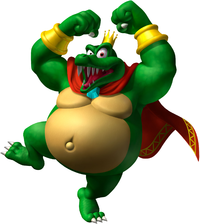Donkey Kong (franchise)
This article is under construction. Therefore, please excuse its informal appearance while it is being worked on. We hope to have it completed as soon as possible.
Template:Articleabout Template:Series-infobox
Donkey Kong (ドンキーコング Donkī Kongu) is a video game series that follows the adventures of an anthropomorphic gorilla named Donkey Kong and his various friends. Created in 1981 by famed Nintendo game designer Shigeru Miyamoto, it mainly consists of platform games and action puzzle games, but has branched out into other genres, including rhythm games, racing games, and edutainment.
The games of the first generation are single-screen platform/action puzzle games, where Donkey Kong features as the opponent in an industrial construction setting. The first game in the series, the 1981 arcade machine Donkey Kong, not only introduced the title character but also his rival Mario. After four years of success on arcades and in the "Game & Watch" handheld line, the series was brought to an end as Mario went on to star in Super Mario Bros., for which he is much better known, and take his place as Nintendo's flagship character. Donkey Kong was put on hiatus until 1994, when Rare, Ltd. revived the property with its side-scrolling platform game Donkey Kong Country. That game and its follow-ups focus on the adventures of Donkey Kong and the various members of his clan as they work to defend their native jungle setting from a variety of other anthropomorphic-animal characters who serve as villains. They are most frequently antagonized by the Kremlings, a race of crocodiles, and their leader King K. Rool. A hallmark of this series is the barrels used by the Kongs as weapons, vehicles, furniture, and lodging.
The Donkey Kong character is highly recognizable and popular, and the games have sold over 40 million units worldwide.[1]
Characters
The main character Donkey Kong, a muscular and somewhat dim-witted ape, first appeared in the eponymous arcade game in 1981 as the antagonist. In the later generations of the series, he became the main protagonist, and the defender of his carefree jungle home and his various primate friends. In the arcade game Donkey Kong Jr., he was given a son, also named Donkey Kong Jr., who had to save his father from Mario in that character's only appearance as a villain.
When the Donkey Kong property was revived for Donkey Kong Country, the original Donkey Kong character was reworked into a new character named Cranky Kong, an elder who constantly rambles and berates the younger generation of heroes. Cranky has been called the modern DK's grandfather by some sources, and his father by others. In his debut appearances, Cranky gave out randomly selected advice to the heroes on items and locations found within the game. In later games, he appeared as a potion-making chemist who granted special abilities to the heroes, and eventually as a fully playable character.
Diddy Kong is the modern DK's travel companion and best friend, nicknamed by him as his "little buddy." He was first introduced in Donkey Kong Country and then reappeared in its sequel. In many of his appearances, Diddy helps DK keep his island safe from whatever villain threatens to destroy it. In the Donkey Kong Country sequels, he gained a girlfriend, Dixie Kong, who is capable of flying in the air with her hair. Donkey Kong Country 3 gave Dixie a sidekick, Kiddy Kong, believed to be her cousin, who despite being a toddler has amazing strength that rivals even Donkey Kong himself.
A number of other members have been added to the Kong clan as the series has progressed, taking on both playable and non-playable roles. Funky Kong, one of DK's longest-standing friends and allies, often aids the Kongs through such means as selling and operating flight services. DK's love interest, Candy Kong, also helps him through various means, including running a music shop. In Donkey Kong Country 2, Cranky gained a wife, Wrinkly Kong, who managed her own school; by Donkey Kong 64, she was revealed to be deceased, and all her appearances after that game portray her as a ghost. Donkey Kong 64 introduced three new playable Kongs: Tiny Kong, a nimble and fast girl who is believed to be Dixie's younger sister, but in her later appearances has been redesigned to be taller than she; Lanky Kong, the joker of the clan, who despite his bizarre appearance and personality proves to be a capable fighter with his abnormal physique and lengthy arms; and Chunky Kong, Kiddy's older brother, who is physically the strongest and largest Kong in the family. Not all friendly characters in the series are Kongs, however; DK and his friends are sometimes helped by other anthropomorphic-animal characters, the most recurring being Rambi the Rhino and Squawks the Parrot.
The main antagonist of the Donkey Kong series is King K. Rool, the malevolent ruler of a race of crocodiles called the Kremlings, who has repeatedly attempted to disrupt the peace of Donkey Kong Island by means ranging from stealing the island's banana hoard to kidnapping some of the Kongs themselves. He, however, is not the only villain in the series. In Diddy Kong Racing, Diddy and his friends must confront Wizpig, a gigantic alien pig who loves to race those who challenge him, causing all sorts of chaos in the process. In Donkey Kong Jungle Beat, DK has to face a few evil Kong characters exclusive to the game, and their leader, Ghastly King. Donkey Kong Country Returns puts the Kongs up against the Tiki Tak Tribe, a race of floating wooden tiki masks which make music that has the power to hypnotize. In Tropical Freeze, DK and his clan face the Snowmads, an army of stereotypical Viking-themed arctic and antarctic animals, who seize the territory they invade by summoning a massive wind that throws the affected area into a state of perpetual winter.
Basic gameplay
The arcade games have simple gameplay where the player moves along the playfield, avoiding obstacles and enemies. In the original Donkey Kong, the playfield is a series of girders on a construction site, and the obstacles are barrels thrown by Donkey Kong.
In the side-scrolling games of the Donkey Kong Country series, players venture through uniquely themed levels and undertake varying tasks such as swimming, riding in mine carts, launching out of barrel cannons, or swinging from vine to vine. Most enemies can be defeated by a roll, jump, or ground slam which can also reveal secret items. However, some enemies that are more difficult to defeat will require the use of a barrel or the help of an animal friend. Throughout the levels are scattered several types of items that can be helpful to players and grant them additional lives, such as bananas which award an extra life if 100 are collected in a single play; Extra Life Balloons; and four golden letters that spell out K–O–N–G, which depending on the game can add to the player's life count or unlock a bonus or hidden level.
Video games
Series
| Series | ||
|---|---|---|
| Artwork | Summary | List of Games |
| Donkey Kong series | ||
| File:464px-DonkeyKongArcade.jpg | Template:Sectionstub |
|
| Donkey Kong Country series | ||

|
The Donkey Kong Country series is a video game sub-series of the Donkey Kong series. Although it usually stars Donkey Kong and his pal, Diddy Kong, Donkey Kong also ends up as a damsel in distress in some games. The series is a platformer-type; levels are shown in a sidescrolling perspective and the heroes must jump and avoid obstacles in order to clear levels. The series was started by Rare, Ltd., until they were bought by Microsoft. Remakes are included in the Game Boy Color and the Game Boy Advance. The series were later revived by Retro Studios and their game, Donkey Kong Country Returns. The Donkey Kong Country series also has well-received reviews and has greatly impacted future titles. |
|
| Donkey Kong Land series | ||
| File:DKLTitleScreen.png | The Donkey Kong Land series is an 8-bit video-game sub-series in the Donkey Kong series, created by Rareware for the Game Boy systems. The series' three games star Donkey Kong, along with other members of the Kong clan, Diddy, Dixie, and Kiddy, who travel through numerous levels in order to defeat King K. Rool and his aliases. |
|
| Diddy Kong Racing series | ||
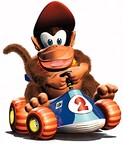
|
Diddy Kong Racing games have been produced since 1997 with Diddy Kong Racing for the Nintendo 64. It features Diddy Kong and an all-star cast competing in a racing game. It is very similar to the Mario Kart series but features only Donkey Kong characters. Since its first generation on the Nintendo 64, a long hiatus was caused by Rare's buy-out by Microsoft, and two DKR games that had been in production had to be cancelled. In 2007, a remake of Diddy Kong Racing was eventually released on the Nintendo DS. |
Canceled Games
|
| Donkey Konga series | ||
| File:DKonga DonkeyKong.jpg | Donkey Konga games have been being made since 2003 when Donkey Konga was released. All three installments include bongos which are also compatible with Donkey Kong Jungle Beat. It mostly features Donkey Kong and Diddy Kong but Dixie Kong and even Ellie the elephant have appeared in the series. All three installments are made only for the GameCube. The latest release was in 2005 with Donkey Konga 3: Tabehōdai! Haru Mogitate 50 Kyoku, released only in Japan. |
|
| Mario vs. Donkey Kong series | ||
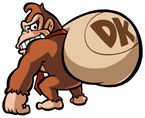
|
Mario vs. Donkey Kong is a series of four games so far, consisting of modernized retailings of the original Donkey Kong game. They feature a comeback of Pauline, and Donkey Kong Vs. Mario rivalry. |
|
| DK series | ||
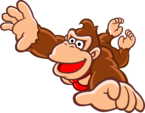
|
The DK series is a small series of handheld games. The first production in America is DK: King of Swing for the Game Boy Advance. The latest installment is DK: Jungle Climber. | |
Other games
| Title | |
|---|---|
| Cover, original release and system | Synopsis |
| Donkey Kong Jungle Beat | |
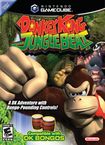 Template:ReleasedateGameCube |
Donkey Kong Jungle Beat is the first successful GameCube title starring Donkey Kong. This game uses DK Bongos to play, an innovative way to control the characters in the game and also a very simple way to play. This game was developed shortly after Rare left Nintendo, as they were bought out by Microsoft. As a result, no old characters from the previous Donkey Kong games returned. This game was later released on the Wii under the New Play Control! series. |
| Donkey Kong: Jungle Fever | |
 Template:ReleasedateArcade |
Donkey Kong: Jungle Fever is a Japan-only Donkey Kong arcade game made in 2005 and sequel to Donkey Kong: Jungle Beat. The game received another Japan-only arcade sequel titled Donkey Kong: Banana Kingdom. |
| Donkey Kong: Banana Kingdom | |
 Template:ReleasedateArcade |
Donkey Kong: Banana Kingdom is a Japan-only Donkey Kong game found in the arcade. It is a sequel to Donkey Kong: Jungle Beat and Donkey Kong: Jungle Fever. Not much information about this game is known, and its relation to the Banana Kingdom is unknown. It was developed by Capcom. It was released in Japan on November 16, 2006. |
| Donkey Kong Barrel Blast | |
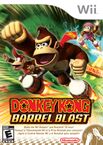 Template:ReleasedateWii |
'Donkey Kong Barrel Blast is a Donkey Kong racing game for the Wii. Instead of cars, players utilize rocket-powered bongos. The title was originally planned for the Nintendo GameCube for use with the DK Bongo Controller. The game incorporates Miis. |
Cancelled Games, Tech Demos and miscellany
- For cancelled games from a series listed above, see the individual series article
| Title | |
|---|---|
| Image and planned system | Summary |
| Donkey Kong Coconut Crackers | |
 Unreleased Game Boy Advance |
Donkey Kong Coconut Crackers was a puzzle game developed by Rare. The company was bought by Microsoft before completing it, leading to the game being reworked as It's Mr. Pants. |
| Donkey Kong Advance | |
| File:DK Advance.png Unreleased Game Boy Advance |
The Nintendo DS NTR Debug Cartridge includes two graphics with the name "Donkey Kong Advance". It is currently unknown what the name was used for. |
Other media
Due to its success, the Donkey Kong franchise has been the subject of many television shows, chapter books and comics/manga, most of which were produced at the peak of Donkey Kong Country's popularity in the late 90's.
Television
- Main articles: Saturday Supercade, Captain N: The Game Master, Donkey Kong Country (television series), La planète de Donkey Kong
Donkey Kong was one of the games adapted in the Saturday Supercade, an animated anthology themed after the Golden Age of arcade games. The Donkey Kong segments featured Donkey Kong being chased by Mario and Pauline accross the world, while often also being chased or manipulated by crooks. Another segment starred Donkey Kong Jr. and a clumsy biker named Bones as they traveled in search of the missing Donkey Kong.
Donkey Kong’s next television role would be as a recurring character in the first two seasons of DiC Entertainment's Captain N: The Game Master. A crossover featuring many first-party and third-party franchises on the NES, Captain N starred a team made of Simon Belmont , Mega Man , Kid Icarus , and original characters Kevin and Princess Lana as they fought to protect the video game dimension Videoland from the evil forces of Mother Brain. The show portrayed Donkey Kong as a giant ape who would attack anyone intruding his home of Kongo Land, with some episodes showing him starring in a television series parodying Indiana Jones . Following its cancellation in 1991, Captain N was reedited and reran under the syndication package Captain N & The Video Game Masters , along with other DiC Nintendo cartoons.
The franchise would receive its first direct television adaptation in 1996 with Donkey Kong Country. Produced by Nelvana and Medialab (the later replaced by Hong Guang Animation for the show's final season), Donkey Kong Country had Donkey Kong and friends protecting the wish-granting Crystal Coconut from being stolen by King K. Rool and his two idiotic henchmen, Krusha and General Klump. Like the game it was based on, the Donkey Kong Country animated series was a technological innovator: in addition to being of the first computer-animated television series, it was the first full-length television series to be animated using motion capture.
Parralel to Donkey Kong Country, Medialab also produced and animated La planète de Donkey Kong from 1996-2001 for France 2. A programming block-type show for France 2's children programming, La planète de Donkey Kong consisted of airing of various children series framed by segments starring Donkey, Diddy, Funky, and Candy Kong as the hosts of various musical and parodic skits. Though ostensibly aimed toward children, La planète de Donkey Kong was acclaimed for its irreverent post-modern humor.
Literature
Manga
- Main articles: KC Deluxe, Super Mario-Kun, Donkey Kong (CoroCoro Comics)
A short-lived manga based on the Donkey Kong Country animated series was published by CoroCoro Comics in 2000.
Western comics
- Main articles: Donkey Kong Country (comic), Donkey Kong in: Banana Day 24, Donkey Kong in When the Banana Splits
Children's books
- Main articles: Donkey Kong Country (novel), Donkey Kong: Rumble in the Jungle, Donkey Kong Country: Rescue on Crocodile Isle, How to Draw Donkey Kong & Friends
Children chapter book author Michael Teitelbaum wrote a trilogy of Donkey Kong Country chapter books from 1994-1996 for publisher Troll Communications. The first book, Donkey Kong Country was a loose adaptation of the game, featuring Donkey Kong, Diddy Kong, and Cranky Kong exploring Donkey Kong Island to destroy the Kremling’s polluting factory and defeat the Kremlings, meeting various enemies and Animal Friends along the way. It was followed the next year by Donkey Kong: Rumble in the Jungle (based on Donkey Kong Land), and by Donkey Kong Country: Rescue on Crocodile Isle (based on Donkey Kong Country 2 ) in 1996. Teitelbaum also produced a How to Draw book, appropriately titled How to Draw Donkey Kong & Friends, in 1997.
Merchandising
- Main articles: Donkey Kong Card Game, Gallery:Donkey Kong Country (television series) trading cards, Donkey Kong Jenga
A Donkey Kong toy line was made by a company called Toy Site.
A Diddy Kong Racing toy line was made by Toy Biz in 1999.
